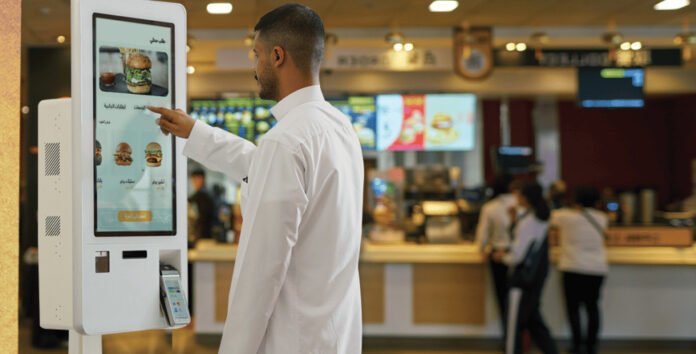Introduction
Thailand’s service industry is undergoing a digital transformation, with self-ordering systems becoming increasingly prevalent across various sectors. These systems empower customers to place orders, customize selections, and make payments independently, reducing the need for direct staff interaction. Initially popularized in quick-service restaurants, self-ordering technologies have now permeated retail, healthcare, hospitality, and transportation industries.
The integration of digital kiosks, mobile applications, and QR code menus has streamlined operations and enhanced the overall customer experience. This article explores the components, benefits, challenges, and future prospects of self-ordering systems in Thailand, highlighting their impact on both consumers and businesses.
Components of Self-Ordering Systems
Self-ordering systems in Thailand comprise several key components designed to facilitate seamless transactions:
- Digital Kiosks: Interactive touchscreens installed in establishments allow customers to browse menus or product catalogs, customize orders, and complete payments without staff assistance.
- Mobile Applications: Businesses offer dedicated apps enabling customers to place orders remotely, schedule pickups or deliveries, and access personalized promotions.
- QR Code Menus: By scanning QR codes placed on tables or counters, customers can access digital menus, place orders, and make payments using their smartphones, promoting a contactless experience.
- Integrated Payment Systems: Support for various payment methods, including mobile wallets, credit/debit cards, and bank transfers, ensures flexibility and convenience for users.
- Real-Time Order Processing: Orders are instantly transmitted to the relevant departments, such as kitchen staff or inventory management, ensuring prompt preparation and fulfillment.
Benefits of Self-Ordering Systems
The implementation of self-ordering systems offers numerous advantages for both customers and businesses:
- Enhanced Customer Experience: Customers enjoy greater control over their orders, reduced wait times, and the convenience of contactless transactions.
- Operational Efficiency: Automation of the ordering process reduces the workload on staff, allowing them to focus on other critical tasks and improving overall service speed.
- Accuracy and Consistency: Digital systems minimize human errors in order taking, ensuring that customers receive exactly what they requested.
- Data Collection and Analysis: Businesses can gather valuable insights into customer preferences and purchasing behaviors, enabling targeted marketing strategies and inventory optimization.
- Cost Reduction: By decreasing reliance on manual labor for order processing, businesses can lower operational costs and allocate resources more effectively.
Industry Applications in Thailand
Self-ordering systems have been adopted across various industries in Thailand, each leveraging the technology to meet specific needs:
Food and Beverage
Restaurants and cafes utilize self-service kiosks and QR code menus to streamline the ordering process, reduce queues, and enhance customer satisfaction. For instance, McDonald’s Thailand has implemented digital kiosks that allow customers to customize their meals and pay without interacting with staff.
Retail
Supermarkets and convenience stores have introduced self-checkout stations, enabling shoppers to scan items, bag purchases, and complete payments independently, thereby reducing wait times and improving store efficiency.
Healthcare
Hospitals and clinics employ self-service kiosks for patient registration, appointment scheduling, and bill payments, minimizing administrative burdens and expediting service delivery.
Hospitality
Hotels offer self-check-in and check-out kiosks, allowing guests to manage their accommodations with ease and reducing the need for front desk interactions.
Transportation
Airports and bus terminals have adopted self-service ticketing machines and check-in kiosks, facilitating faster processing and enhancing traveler convenience.
Challenges and Considerations
Despite the benefits, the adoption of self-ordering systems presents certain challenges:
- Initial Investment: The cost of procuring and installing digital kiosks or developing mobile applications can be substantial, potentially deterring small businesses.
- Technical Issues: System malfunctions or connectivity problems can disrupt operations and negatively impact the customer experience.
- Digital Literacy: Some customers, particularly the elderly or those unfamiliar with technology, may find self-ordering systems intimidating or difficult to use.
- Maintenance and Updates: Regular maintenance and software updates are necessary to ensure system reliability and security, requiring ongoing investment and technical support.
- Data Privacy: The collection and storage of customer data necessitate stringent security measures to protect against breaches and comply with privacy regulations.
Future Prospects
The evolution of self-ordering systems in Thailand is poised to continue, driven by technological advancements and changing consumer behaviors:
- Artificial Intelligence (AI): Integration of AI can enable personalized recommendations, predictive ordering, and enhanced customer interactions.
- Voice Recognition: Voice-activated ordering systems can provide a hands-free, accessible option for customers, further simplifying the ordering process.
- Augmented Reality (AR): AR technology can offer interactive menu displays, allowing customers to visualize products before making selections.
- Blockchain Technology: Utilizing blockchain can enhance payment security and transparency, building customer trust in digital transactions.
- Integration with IoT Devices: Connecting self-ordering systems with Internet of Things (IoT) devices can streamline inventory management and real-time order tracking.
self ordering system in thailand – ระบบสั่งออเดอร์สินค้าด้วยตนเองในประเทศไทย
Conclusion
The adoption of self-ordering systems in Thailand signifies a pivotal shift towards digital transformation in service delivery. By empowering customers with greater autonomy and streamlining business operations, these systems enhance efficiency, accuracy, and overall satisfaction. While challenges such as initial investment costs and the need for technical support exist, the long-term benefits for both consumers and businesses are substantial.
As technology continues to evolve, the integration of advanced features like AI, AR, and blockchain will further revolutionize the self-ordering experience. Embracing these innovations positions Thai businesses at the forefront of customer-centric service, catering to the modern consumer’s demand for convenience and personalization.
